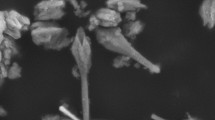Abstract
Jarosite precipitation is a useful means of stabilizing toxic species, and accordingly, the factors affecting the precipitation of chromium(III) in jarosite-type compounds was systematically investigated in a series of laboratory experiments. Although end-member Cr(III) analogues of jarosite-type compounds could not be precipitated at temperatures <100 °C, several percent Cr(III) substitution for Fe(III) in potassium jarosite and sodium jarosite was observed. However, at temperatures >200 °C, the Cr(III) analogue of potassium jarosite (KCr3(SO4)2(OH)6) is readily precipitated. The Cr(III) analogue has the R \(\bar 3\) m structure characteristic of jarosite-type compounds, with a=7.23±0.02Å and c=17.02±0.02 Å. The well-crystallized material typically contains (wt pct): ∼7K, ∼25Cr, and ∼41SO4. The composition suggests the partial substitution of hydronium ion for potassium and some chromium vacancies in the structure. The formation of the Cr(III) analogue is promoted by increasing temperatures, retention times, and Cr(III) concentrations. Increasing acid concentrations reduce the amount of product formed but suppress the undesirable precipitation of amorphous phases. Although increasing K2SO4 concentrations result in a greater mass of precipitate, the products formed from concentrated K2SO4 solutions are contaminated with an amorphous phase. In fact, the overall results suggest that an amorphous phase precipitates initially and that the Cr(III) analogue of potassium jarosite forms by the recrystallization, or the dissolution-reprecipitation, of the amorphous phase.
Similar content being viewed by others
References
A.H. Sully and E.A. Brandes: Chromium, Butterworth and Company, London, 1967.
R.M. Grant: in World Zinc ’93, I.G. Matthew, ed., Australasian Institute of Mining and Metallurgy, Parkville, Australia, 1993, pp. 391–97.
F.A. Cotton and G. Wilkinson: Advanced Inorganic Chemistry, 4th ed., Interscience Publishers, New York, NY, 1980.
J.E. Dutrizac and J.L. Jambor: in Sulfate Minerals—Crystallography, Geochemistry and Environmental Significance, C.N. Alpers, J.L. Jambor, and D.K. Nordstrom, eds., Mineralogical Society of America, Washington, DC, 2000, pp. 405–52.
J.E. Dutrizac: in Hydrometallurgical Process Fundamentals, R.G. Bautista, ed., Plenum Publishing Corporation, New York, NY, 1984, pp. 125–69.
A. Bonnin and A. Lecerf: C.R. Acad. Sci. Paris, Ser. C, 1966, vol. 262, pp. 1782–84.
D. Baron, C.D. Palmer, and J.J. Stanley: Environ. Sci. Technol., 1996, vol. 30, pp. 964–68.
D. Baron and C.D. Palmer: Geochimica Cosmochimica Acta, 1996, vol. 60, pp. 3815–24.
D. Baron and C.D. Palmer: Geochimica Cosmochimica Acta, 2002, vol. 66 pp. 2841–53.
A. Lecerf, A. Bonnin, and A. Hardy: C.R. Acad. Sci. Paris, Ser. C, 1966, vol. 262, pp. 352–55.
C.L. Lengauer, G. Giester, and E. Irran: Powder Diffraction, 1994, vol. 9, pp. 265–71.
U. Kolitsch and A. Pring: J. Mineral. Petrol. Sci., 2001, vol. 96, pp. 67–78.
S.H. Lee, C. Broholm, M.F. Collins, L. Heller, A.P. Ramirez, C. Kloc, E. Bucher, R.W. Erwin, and N. Lacevic: Phys. Rev. B, 1997, vol. 56, pp. 8091–97.
M. Nishiyama, T. Morimoto, S. Maegawa, T. Inami, and Y. Oka: “Magnetic Ordering and Fluctuation in Kagome Lattice Antiferromagnets, Fe and Cr Jarosites,” http://xxx.lanl.gov/pdf/cond-mat/0006343, 2000.
J.E. Dutrizac and S. Kaiman: Can. Mineralogist, 1976, vol. 14, pp. 151–58.
T.T. Chen and J.E. Dutrizac: in Process Mineralogy IX, W. Petruk, R.D. Hagni, S. Pignolet-Brandom, and D.M. Hausen, eds., TMS, Warrendale, PA, 1990, pp. 289–309.
Handbook of Chemistry and Physics, 67th ed., CRC Press, Boca Raton, FL, 1986.
Author information
Authors and Affiliations
Rights and permissions
About this article
Cite this article
Dutrizac, J.E., Chen, T.T. Factors affecting the precipitation of chromium(III) in jarosite-type compounds. Metall Mater Trans B 36, 33–42 (2005). https://doi.org/10.1007/s11663-005-0003-6
Received:
Issue Date:
DOI: https://doi.org/10.1007/s11663-005-0003-6




